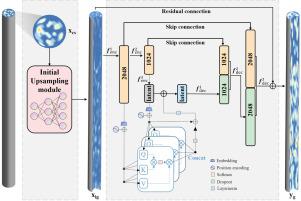基于深度学习的固液两相管流单截面数据三维颗粒体积分数场重建
IF 4.6
2区 工程技术
Q2 ENGINEERING, CHEMICAL
引用次数: 0
摘要
深海采矿垂直提升管固液两相流颗粒体积分数场的准确采集,对系统输送效率和作业安全至关重要。然而,现有的测量只能提供局部信息,而数值模拟的计算量很大,这给从最小的测量信息重建全局油田带来了挑战。本研究建立了一个深度学习模型,从单个截面数据重建全局三维瞬时颗粒体积分数(PVF)场。它采用两阶段架构,具有上采样模块和增强型自动编码器,具有跳过连接和多头交叉注意,以准确捕获复杂的粒子分布。结果表明,该模型具有良好的重构性能,决定系数R2 = 0.962,均方误差= 3.98×10−4,能够准确捕获不规则粒子聚集模式。鲁棒性分析表明,在不同的输入截面位置重建性能稳定,在严重的输入噪声下重建精度可接受。此外,当管柱长度延长到其直径的50倍时,性能略有下降,同时成本呈线性增加,这表明管柱的长度有可能达到其直径的数百倍。迁移学习评估显示,仅使用10%的训练样本就能有效地适应新的颗粒浓度,在保持可接受的准确性的同时,将训练时间减少了90%以上。本文章由计算机程序翻译,如有差异,请以英文原文为准。

Deep learning-based reconstruction of three-dimensional particle volume fraction fields in solid-liquid two-phase pipe flow from single cross-sectional data
Accurate acquisition of the particle volume fraction (PVF) field of solid–liquid two-phase flow in vertical lift pipes in deep-sea mining is crucial for system transport efficiency and operational safety. However, existing measurements provide only localized information while numerical simulations are computationally intensive, creating the challenge of reconstructing global fields from minimal measurement information. This study developed a deep learning model to reconstruct the global three-dimensional instantaneous Particulate Volume Fraction (PVF) field from single cross-section data. It employs a two-stage architecture, featuring an upsampling module and an enhanced autoencoder with skip connections and multi-head cross-attention, to accurately capture complex particle distributions. The results indicate that the model achieves excellent reconstruction performance with a coefficient of determination R = 0.962 and a mean square error = , accurately capturing irregular particle aggregation patterns. Robustness analysis demonstrates stable reconstruction performance across varying input cross-section positions and acceptable accuracy under severe input noise. Furthermore, when the pipe length is extended to 50 times its diameter, a slight performance decrease alongside a linear increase in cost indicates strong potential for application to lengths hundreds of times diameter. Transfer learning evaluation shows efficient adaptation to new particle concentrations using only 10% of training samples, reducing training time by over 90% while maintaining acceptable accuracy.
求助全文
通过发布文献求助,成功后即可免费获取论文全文。
去求助
来源期刊

Powder Technology
工程技术-工程:化工
CiteScore
9.90
自引率
15.40%
发文量
1047
审稿时长
46 days
期刊介绍:
Powder Technology is an International Journal on the Science and Technology of Wet and Dry Particulate Systems. Powder Technology publishes papers on all aspects of the formation of particles and their characterisation and on the study of systems containing particulate solids. No limitation is imposed on the size of the particles, which may range from nanometre scale, as in pigments or aerosols, to that of mined or quarried materials. The following list of topics is not intended to be comprehensive, but rather to indicate typical subjects which fall within the scope of the journal's interests:
Formation and synthesis of particles by precipitation and other methods.
Modification of particles by agglomeration, coating, comminution and attrition.
Characterisation of the size, shape, surface area, pore structure and strength of particles and agglomerates (including the origins and effects of inter particle forces).
Packing, failure, flow and permeability of assemblies of particles.
Particle-particle interactions and suspension rheology.
Handling and processing operations such as slurry flow, fluidization, pneumatic conveying.
Interactions between particles and their environment, including delivery of particulate products to the body.
Applications of particle technology in production of pharmaceuticals, chemicals, foods, pigments, structural, and functional materials and in environmental and energy related matters.
For materials-oriented contributions we are looking for articles revealing the effect of particle/powder characteristics (size, morphology and composition, in that order) on material performance or functionality and, ideally, comparison to any industrial standard.
 求助内容:
求助内容: 应助结果提醒方式:
应助结果提醒方式:


